Databases, Part I: Storing Information In this section you will learn
97 Slides3.57 MB

Databases, Part I: Storing Information In this section you will learn about: how information is stored in databases, different database relations, ways of ensuring data validity Online MS-Office information source: https://support.office.com/

Purpose Of A Database This section: To store information Francesco Rollandin/OpenClipart Database: Customer information

Purpose Of A Database Next section (database queries): To retrieve information information Sale Sale Database: Customer information

Databases: Storing / Retrieving Information As you will see, implementing these two tasks aren’t as easy as it seems. Information must be stored such that: – Information can be quickly retrieved

Databases: Storing / Retrieving Information (2) – The database is designed to reduce problems during maintenance (additions, modifications, deletions) Example: This comes up during database normalization (“if there is time”) One employee has left and the whole department is gone? Information Technology Archie Bunker Marketing Dept. Loren Coleman William McCloud Finance & Accounting Victor Davion Omiko Kurita

With Bother With Databases? Are used to store and retrieve information Why bother, why not use a simple file as an alternative? – E.g., tracking client information MILES EDWARD O’BRIAN DS9 Corp Electrical engineering 2007 purchases: 10,0000,000 2006 purchases: 1,750,000 JAMIE SMYTHE Cooperative services Gasoline refining 2006 purchases: 5,000,0000 2005 purchases: 5,000,0000 2004 purchases: 5,000,0000 2003 purchases: 5,000,0000 2002 purchases: 5,000,0000 SCOTT BRUCE Bryce Consulting Investment analysis 2007 purchases: 500,000 2006 purchases: 1,500,000 2005 purchases: 2,500,000 2004 purchases: 500,000 Etc. If the list is short then a simple text file may suffice As the list grows organizing and updating the information becomes more challenging (duplicates or inaccuracies?) Also searching the list according to specific criteria may become difficult e.g., Show all clients whose purchases in 2007 were between one and five million dollars e.g., Show all clients that made a purchase exceeding 10 million dollars.

Storing Information In A Database Information is stored in tables: The ‘Gamers’ table

Storing Information In A Database (2) Row Record: An example instance of data within the table. – Gamers Table: one row is an example instance of a gamer Table records One record, ‘Harri Masoon’

Storing Information In A Database (3) Column: are that attributes that we track for each record – Gamers Table: each column specifies the information we store about the gamers in this database. Attributes (‘fields’ in Access) of each record

Primary Key Each table should typically have one attribute designated as the primary key: – The primary key must be guaranteed to be unique – It must uniquely identify one record from another Primary Key for table ‘Employees’ is the ‘SIN’ attribute

Choosing A Primary Key A primary key must be unique to each record because it is the one thing that distinguishes them. If there’s at least one instance where the attributes of two records can take on the same value that attribute cannot be a primary key. (When in doubt verify with your users). If a primary key cannot be formed from a single attribute then several attributes can be combined into a composite key. (Each attribute is still a column but together they form a unique primary key for each record). E.g., CourseRegistrations table: Course name, course number, lecture section (CPSC 203 L01) If a unique primary key still cannot be found then ‘invent’ one. E.g., StudentID#, SocialInsuranceNumber

MS-Access: Views Of Your Database Design view – Typically start with this view – Used to specify what attributes that a table will consist of: e.g., GAMES: Title, HourlyRate – Used to specify the type, format and valid range of values e.g., SIN is attribute with 9 characters that must be in the format 000 000 000 Datasheet view Once the attributes have been specified in the Design view using the Datasheet view allows data entry for each record.

Example Problem: Online Games This example can be found online: – http://pages.cpsc.ucalgary.ca/ tamj/2018/203W/database/LectureExample.accdb An online gaming server will allow several online different games to be played Gamers can logon to play a particular game A gamer playing a game will create a ‘session’ that tracks (among other things) the cost of the gaming session (Even though some of the data stores information about games, it’s really just a database example for a business where a product is utilized ‘rental’ for a finite period of time).

Online Gamers: Information To Be Tracked Online identifier: “Call sign” Contact information: Email Contact information: Telephone number Income: A (yearly) numeric figure Real life identifier: First and last name Overall ‘score’ (sum of the player’s accomplishments among multiple games): Level

Online Games: Information To Be Tracked Name of the game: Title The cost of playing a game: Hourly rate

Gaming Sessions: Information To Be Tracked Each time a player starts playing a game, billing information must be generated (attaches the bill to the correct player) – Who played the game (who gets the bill) – Which game was played (how much is the cost per time unit) – How long was the game played (in conjunction with the cost per time unit it determines the amount for the bill)

Picking Tables A table stores related information about an entity – E.g., – Book: Title, author/authors, publisher, edition – Product: Product name, price, description The three groups of information (entities) in this problem appear to map to three database tables – Gamers – Games – Sessions

Guidelines For Naming Tables1 1. Create a unique and descriptive name. – “CaloriesBurnedExercising” vs. “Workout” 2. Consider using the plural form of a name. – “Games table” vs. “Game table” 3. Avoid the use of spaces in names. – “Undergraduate students” vs. “Undergraduate Students” vs. “UndergraduateStudents” 1 Based on the principles from “Databases demystified a self teaching guide” (McGraw Hill) Oppel A. pp 211

Guidelines For Naming Attributes2 1. Create a name that accurately, clearly and unambiguously identifies the characteristic that the attribute represents. – “Name” vs. “FirstName” 2. Use the singular form of a name – Tables store multiple records (e.g., GAMES table), attributes store a single piece of information (e.g., Title for a particular game) – Do not fall into the pitfall of creating composite attributes (phone numbers - NO) vs. (home phone, cell phone etc. – YES) 3. Avoid the use of spaces in names (similar to tables). 1 Based on the principles from “Databases demystified a self teaching guide” (McGraw Hill) Oppel A. pp 211

Type Of Data For An Attribute1 1 Source (last accessed 2017): https://support.office.com/ and the built in Office 2016 help system Most of the time you will select text – Short text: max of 255 characters – Long text: Up to 1 GB of characters (only the first 64,000 displayed) – Text allows data to be entered in specific format (e.g. for formatted postal codes, phone numbers). Not to be used to constrain numeric ranges (e.g. age must be greater than 0). AutoNumber – Automatically generates a sequence of numbers 1,2,3. – Useful for generating unique primary keys if you cannot come up with one

Type Of Data For An Attribute(2) Obvious types: number, date/time, currency – The attribute must be set to date if you want set up error checking rules (“validation rules” – covered later in this section) by date e.g. When entering year of birth for “Generation Z” employees they must have a birth year of 1996 or later. Lookup wizard: when one table’s attribute refers to an attribute of another table (more on this later)

More Advanced Types (If There Is Time) OLE (Object linking and embedding): – Allows ‘objects’ to be inserted e.g. MS-Office documents, images (similar to an email attachment) Hyperlink – Enter the web address, clicking on the attribute will automatically pull up the webpage in the default browser. Calculated – Similar to how one cell in Excel can be derived from the values in other cells – In Access ‘calculated’ allows for the attributes of a table to be mathematically calculated from the attributes of the same table (unless otherwise told explicitly don’t use this for the assignment).

Null Values Refers to the attributes of a record that are empty Primary keys cannot be null but other attributes may be null Entry of any attribute can be made mandatory (if data must be entered then it cannot be null)

Gamers Table: Attributes Gamer information to track: – – – – – – Online identifier: “Call sign” Contact information: Email Contact information: Telephone number Income: A (yearly) numeric figure Real life identifier: First and last name Overall score: Level GAMERS CallSign Email Telephone Income LastName FirstName Level

Games Table: Attributes Game information to track: – Name of the game: Title – The cost of playing a game: Hourly rate GAMES Title HourlyRate

Sessions Table: Attributes Each time a player plays a game billing information must be generated. – Who played the game – Which game was played – How long was the game played This one is trickier! – Identifying ‘who’: need to be 100% certain that the correct gamer has been identified (don’t bill the wrong person) – Identifying ‘which’: again certainty is required because different games have different hourly rates (don’t bill for the wrong game and/or generate a bill for an incorrect amount) – We need to “hold off” on creating a table until the above two requirements can be met

Refinements Needed: Gamers Primary key? GAMERS CallSign Email Telephone Income LastName FirstName Level

Modified Table: Gamers Primary key: CallSign GAMERS CallSign Email Telephone Income LastName FirstName Level

Refinements Needed: Games Primary key? GAMES Title HourlyRate

Modified Table: Games Primary key: Title GAMES Title HourlyRate

The Games Table Again What if the game title was not guaranteed to be unique? Primary key?

The Sessions Table Revisited Recall: Each time a player logs in to play a game, billing information must be generated. Some information need to generate a bill – Who played the game – Which game was played The ‘who’ needed to identify the gamer and the ‘which’ needed to specify the game Now that primary keys have been chosen for those two tables we can specify those two attributes (the primary keys unambiguously identify records from each table ‘who’, ‘which’) SESSIONS CallSign Title

Foreign Key An attribute in one table that refers to an attribute in another table: – E.g. CallSign in the Sessions table actually refers to an actual players ‘call sign’ in the Gamers table – This is important because the CallSign is entered into the Gamers table and not into the Sessions table. GAMERS CallSign Email Telephone Retrieve Cowboy from SESSIONS CallSign Title Cowboy TheTams Retrieve from GAMES Title HourlyRate TheTams 20 Income LastName FirstName

Purpose Of Foreign Keys Using foreign keys can prevent errors Example: when we create a login playing session, we can ensure that we only bill a player that already exists in the Gamers table. Creating a new session Gamers Table (The same principle applies to the ‘Title’ foreign key)

Refinements Needed: Sessions It’s determined that each player can only login once per day (our client informs us about this limitation on usage) Players can login and play over multiple dates For each session we could store the login date and the duration (minutes): SESSIONS CallSign Title SessionDate SessionDuration Cowboy TheTams 9/13/2015 120

Refinements Needed: Sessions Each row in the table is created when a gamer logins on a particular date Primary key? SESSIONS CallSign Title SessionDate SessionDuration Cowboy TheTams 9/13/2015 120

Composite Key Reminder: It’s a primary key that consists of multiple attributes (multiple columns in a database table) Attribute1 Attribute2 Attribute3 Attribute4

Modified Table: Sessions Primary key (composite): CallSign, Title, Date The creation of the primary key ‘makes sense’ intuitively for this example based on the previous restrictions. SESSIONS CallSign Title SessionDate SessionDuration Cowboy TheTams 9/13/2015 120 What would be the primary key if a player could login multiple times in a day?

Relationships Between Tables Relationships occur when an attribute of one table is a foreign key in another table. Multiplicity: indicates how many instances of a particular item participates in the relationship: 1. One to one 2. One to many 3. Many to many

Multiplicity 1. One to one relationships – One entity participates in the relationship from the ‘left’ and one entity participates in the relationship from the ‘right’. – Person : Head – Gamers : CallSign – This type of relationship is rare in databases e.g. “DepartmentHead” and “Department” vs. “SIN” and “Employee” 2. One to many relationships – On one side of the relationship one entity participates in the relationship while on the other side: zero or more entities may participate in the relationship. – This is the typical type of database relation – Person : Hair – Gamers : Sessions : Games

Multiplicity (2) 3. Many to many relationships – On each side of the relationship zero or more entities may participate in the relationship. – E.g., Travelers : Destinations – A theoretical database relationship, not directly implemented Travelers table Destinations table TravelerID LastName FirstName DestinationID DestinationName 1 Tam James 1 Dubai 2 Jones Mary 2 Paris 3 Smith Jon 3 Cairo 4 Vulcan

Multiplicity (3) Many to many relationships – Typically implemented as two one to many relationships in databases: Travelers table Destinations table TravelerID LastName FirstName DestinationID DestinationName 1 Tam James 1 Dubai 2 Jones Mary 2 Paris 3 Smith Jon 3 Cairo 4 Vulcan Trips table TravelerID DestinationID Date 1 1 Sept 1 2015 2 3 Sept 1 2015 2 4 Sept 8 2015

Many To Many: Ignoring The Rule Travelers table TravelerID LastName FirstName Dest1 Dest2 Dest3 1 Tam James Dubai 2 Jones Mary Dubai Cairo Vulcan 3 Smith Jon NY Vulcan Destn Zimbobway

Many To Many: Ignoring The Rule (2) Destinations table DestinationID DestinationName Trav1 Trav2 Trav3 1 Dubai Alice Bob Bill 2 Paris Alice Bill Charlie 3 Cairo Alice Bill 4 Vulcan Jim Karen (Gamers : Games) could be implemented as a many to many relationship (by-passing the Sessions table) but problems similar to the previous example would be encountered. Travn Zeek

Primary-Foreign Keys Again When there is a one to many relationship the primary key of the ‘one’ side becomes a foreign key on the ‘many’ side. Examples: 1 – Gamers Many : CallSign: Primary key 1 Title: – Games : Primary key Sessions CallSign: Foreign key Many Title: Sessions Foreign key This should make intuitive sense: the primary key uniquely identifies a record so it ‘should’ be on the ‘one’ rather than the many side

Diagrammatically Representing Database Tables Entity-Relation diagrams (E-R Diagrams or E.R.D.s): show the attributes of a table Format TABLE NAME Primary key Attribute Attribute Example GAMES Title HourlyRate

Diagrammatically Representing Relationships ERDs Graphically represent relationships between tables as well as any enforced rules on multiplicity: Person Person 1 1 1 * Travelers Gamers * * * 1 Head 1 Hairs Person Destinations Travelers Sessions * 1 Games Hairs Destinations

The ERD For The Example Database GAMERS CallSign 1 Email GAMES 1 Telephone Income Title HourlyRate LastName FirstName SESSIONS Level Title * * CallSign SessionDate SessionDuration Note: the line specifying relationships between tables goes from the primary key to the foreign key (e.g. ‘CallSign’ in ‘Gamers’ to ‘CallSign’ in ‘Sessions’

Data Integrity High level description: prevent errors Some uses (there are others) – Type checking: prevent the wrong type of information from being entered e.g. alpha instead of numeric – Range checking: prevent information outside the acceptable range from being entered (e.g. negative age) – Format checking: prevent information in the wrong form from being entered (e.g. postal code N0N0N0 vs. N0N-0N0 vs. N0N 0N0)

Types Of Data Integrity In Databases 1. Table-level integrity (entity integrity): – Ensuring that no duplicate records exist. – Implementation: no primary keys are null: MS-Access (automatic) indexed – no duplicates. 2. Relationship-level integrity (referential integrity): – Ensuring that relationship between a pair of tables is sound and the records in the tables are synchronized when data is entered into, updated in or deleted from either table (MS-Access: only partially implemented). – Partial implementation in Access: use ‘lookup’ for the ‘data type’ of an attribute & enforcing referential integrity. 3. Field/attribute -level integrity (domain integrity): – Ensuring that the attributes are valid and accurate (the previous slides 3 examples) – MS-Access implementation: input masks and validation rules.

2. Relationship Level Integrity Create the foreign-primary key relationship (Design view)

Relationship Level Integrity: Creating The Relationship Create the foreign-primary key relationship (Design view)

Relationship Level Integrity: Creating The Relationship (2) Specify that the lookup value will come from another table Specify the table (for CPSC 203)

Relationship Level Integrity: Creating The Relationship (3) Specify the foreign-primary key (attribute being looked up). Later sub-steps 1. Click next. 2. No need to sort the results 3. Adjust column width if you wish

After Creating The Relationship You may edit the relationship Strengthen the relationship: “Enforce referential integrity”

JT’s Note Set up the relationship between tables as soon as possible. That’s because other parts of the database may not work properly if set up the relationship afterwards. For this class make sure that you ‘Enforce referential integrity’

Input Masks Ensures the proper format for the data entered into the database Example: SIN number must be entered as: – three digits space three digits space three digits Invalid inputs: Abc def ghi 321 22 4234 Online example: Telephone number format – ( area code ) 3 digits - 4 digits – Example: (403)210-9455

Defining Input Masks Switch to ‘design view’ (The data type needs to be ‘short text’ which is the default) Specify the required format under the ‘Input mask’ property of the appropriate table attribute

Use Of Input Masks How it works: Constrains input allowed – – – – Can only enter a single digit Can only enter a single character Can only enter 5 digits (zip code) Etc. Benefits: – “Ignores” invalid inputs in real-time – Specifies the format of data to be entered (data entry cues)

Input Mask Codes Source (last accessed Sept 2015): – https://support.office.com/ Desired input A digit (0 9) can be entered A digit (0 9) must be entered Digits, space (default – data entry skipped), plus or minus sign Alphabetic letter must be entered Alphabetic letter can be entered Alphabetic letter or digit must be entered Alphabetic letter or digit can be entered Converts characters that follow to upper case Converts characters that follow to lower case Character to enter as the input mask 9 0 # L ? A a

Input Masks: Online Database Example Gamers table, level: always displays with ‘L’ at the beginning and then followed by one or two digits

Characters That Are Displayed But Not Part Of The Table Attributes Entering a slash ‘\’ into the input mask (design view) will display a character in the datasheet (data entry) view – This can be a helpful data entry/formatting cue e.g. phone (area code)digits-digits

Characters That Are Displayed But Not Part Of The Table Attributes (2) Note: the characters followed by a slash are NOT saved into the field of the database table Example Note: the data for the ‘A’ is saved for ‘Age1’ but not for ‘Age2’ Vs. This can make a significant difference when later searching the database ‘queries’ ‘A12’ can show up as a result for ‘Age1’ ‘A23’ will not show up as a result for ‘Age2’

Multiple Slashes Quotes If multiple “slash characters” (along with other characters) are used in immediate succession then Access will replace them with double quotes – This can be a handy shortcut

Input Masks: Include The Slashes Or Not AGAIN: the character after the slash (or within the double quotes) will be displayed when the record is entered in the datasheet view. Benefits – A handy reminder of the format and type of data being entered – Reduces the need for repetitive data entry (i.e. if always the same for each record why require that it’s entered each time) and reduces data entry errors (typos) Drawback: – AGAIN: the character after the slash (within the quotes) are not part of the attribute and cannot be entered or searched – E.g. all phone numbers in the above example must display with a 403 area code but you cannot search for 403 area codes.

Input Masks: Online Database Example Gamers table, telephone number: bracketed 3 digit area code, 3 digits, dash, 4 digits

Validation Rules Validation rules check the data is in the valid range. E.g., from online database example: Gamers table, income must be a non-negative value Can also be used to specify a data format (format of a “character string” E.g., from online database example: Gamers table, a valid email must have an “at-sign” ‘@’ and end in one of the following suffixes ‘.ca’, ‘.com’, “.org” Unlike input masks validation rules allows useful error messages to be displayed

Validation Rules: Specifying Error Messages “Validation text” & “default values”

Example Database: Application Of The Validation Rules Gamers table – CallSign: first character must be alphabetic – Email: must include an ‘at-sign’ @ and then end in: ‘.ca’, ‘.com’ or ‘.org’ – Income: no negative values Games table – HourlyRate: a dollar value from 1 to 100. Sessions table – SessionDate: date must be from Sept 12 2015 onwards – SessionDuration: specifies the number of seconds in the range of 0 – 86,400

Validation Rules: Online Database Example (Single Range) Gamers table: Income (non-negative only)

Validation Rules & Logic Logic can combine the conditions specified in validation rules AND (common) – All conditions must be met before the data is deemed as valid Format: (Condition1) And (Condition 2) Example: 0 And 118 OR (rare for numeric ranges more common for character strings) – At least one condition must be met before the data is deemed as valid Format: (Condition1) Or (Condition 2) NOT (rare in databases) Format: Not (Condition)

Validation Rules: Online Database Example (Two Ranges) Games table: HourlyRate (a dollar value 1 - 100) Student exercise: Sessions table, SessionDuration: Specifies the number of seconds from 0 – 86,400

Validation Rules: Online Database Example (Date Ranges) Sessions: SessionDate: date must be from Sept 12 2015 onwards: – The date must be enclosed in a “number sign” pair # date #

Validation Rules: Specifying The Format Character Strings Character string: A sequence of characters (alpha, numeric and other characters) e.g. NX-01 Desired input Value to enter into validation string [A-Z] Example use Digit only [0-9] # Like "[0-9]" (single digit) Like "[0-9][0-9]" (two digits) Like “###” (three digits) Wildcards * ? Like “*” (anything) Like “?” (any single character) Alphabetic only (case insensitive) Like “[A-Z]” (single alpha) Like “[A-Z][A-Z]” (two alpha)

The Wildcard A value that can be used in place of other values. Example: “The joker is wild” option in card games Example: “*.docx” only documents ending in the suffix “.docx” with any name will be considered. The start character ‘*’ is a wildcard because it can be substituted by zero or more characters – Example documents that will considered resume.docx A.docx .docx fulfills the wildcard requirement but is not a valid filename. – Example documents that won’t be considered resume.doc Me.jpg The wildcard can be used in conjunction with validation rules

Validation Rules: Online Database Example (Simple Character String) Gamers table: CallSign (first character must be alphabetic) – O.K. – Not O.K.

Validation Rules: Online Database Example (Complex Character String) Gamers table: Email (must contain an ‘at-sign’ in the string and the string ends with ‘.com’, ‘.ca’, ‘.org’ – O.K. – Not O.K.

Input Masks Vs. Validation Rules: Error Handling Input masks – Can specify desired input beforehand, real-time error prevention Validation Rules – Default values can be specified – Customized and detailed error messages can be created However, messages appear after erroneous data has been entered

Input Masks Vs. Validation Rules: Error Handling Range checking e.g. age 0 – Use a validation rule In general both can be used to check the format of the data – E.g. digit digit alpha Entering an arbitrary number of characters – Use a validation rule: Use of the multi-character wildcard (not possible using an input mask)

Documenting A Database Documentation: Provides information about the database to the other people who will be working on database. In MS-Access documentation can be entered in the “Description” column (under the Design view) It can provide information about the type and format of the information to be stored. – Can be used if errors are found. (Providing the original ‘intention’ if there is an error in the validation rules or the input mask can help others correct the error).
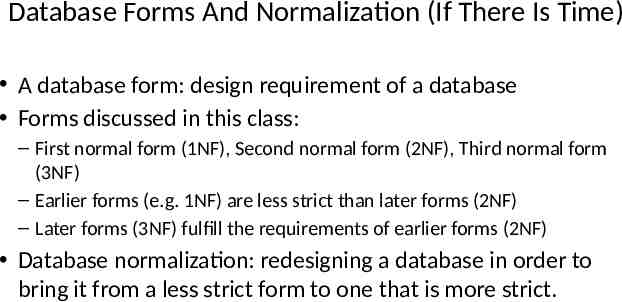
Database Forms And Normalization (If There Is Time) A database form: design requirement of a database Forms discussed in this class: – First normal form (1NF), Second normal form (2NF), Third normal form (3NF) – Earlier forms (e.g. 1NF) are less strict than later forms (2NF) – Later forms (3NF) fulfill the requirements of earlier forms (2NF) Database normalization: redesigning a database in order to bring it from a less strict form to one that is more strict.
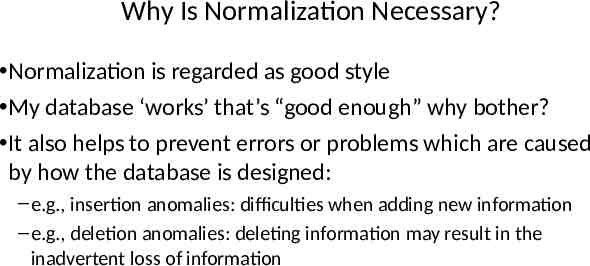
Why Is Normalization Necessary? Normalization is regarded as good style My database ‘works’ that’s “good enough” why bother? It also helps to prevent errors or problems which are caused by how the database is designed: – e.g., insertion anomalies: difficulties when adding new information – e.g., deletion anomalies: deleting information may result in the inadvertent loss of information
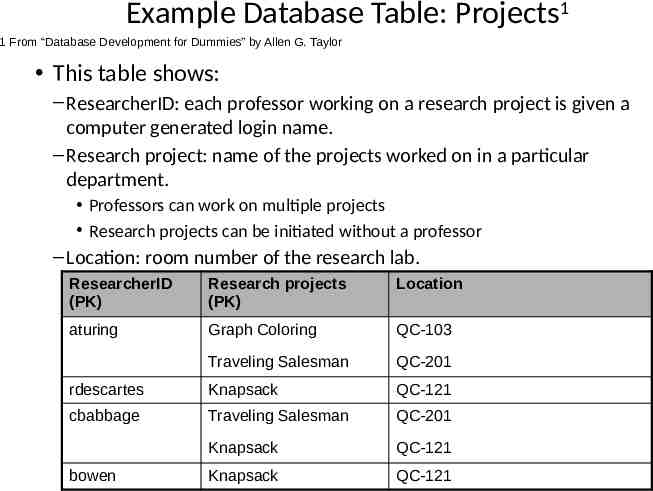
Example Database Table: Projects1 1 From “Database Development for Dummies” by Allen G. Taylor This table shows: – ResearcherID: each professor working on a research project is given a computer generated login name. – Research project: name of the projects worked on in a particular department. Professors can work on multiple projects Research projects can be initiated without a professor – Location: room number of the research lab. ResearcherID (PK) Research projects (PK) Location aturing Graph Coloring QC-103 Traveling Salesman QC-201 rdescartes Knapsack QC-121 cbabbage Traveling Salesman QC-201 Knapsack QC-121 Knapsack QC-121 bowen
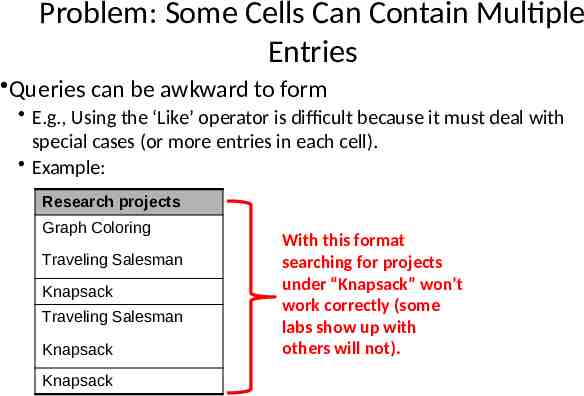
Problem: Some Cells Can Contain Multiple Entries Queries can be awkward to form E.g., Using the ‘Like’ operator is difficult because it must deal with special cases (or more entries in each cell). Example: Research projects Graph Coloring Traveling Salesman Knapsack Traveling Salesman Knapsack Knapsack With this format searching for projects under “Knapsack” won’t work correctly (some labs show up with others will not).
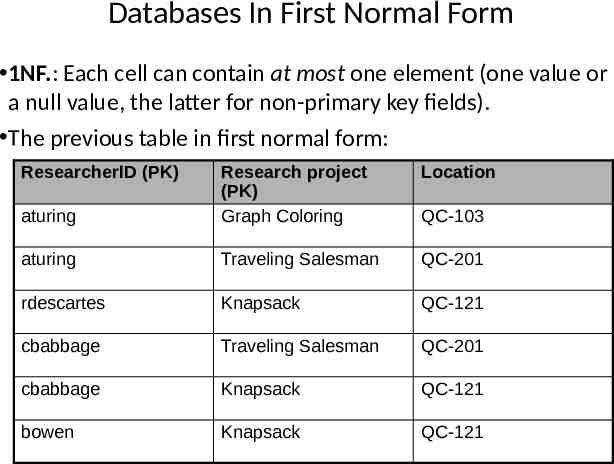
Databases In First Normal Form 1NF.: Each cell can contain at most one element (one value or a null value, the latter for non-primary key fields). The previous table in first normal form: ResearcherID (PK) Location aturing Research project (PK) Graph Coloring aturing Traveling Salesman QC-201 rdescartes Knapsack QC-121 cbabbage Traveling Salesman QC-201 cbabbage Knapsack QC-121 bowen Knapsack QC-121 QC-103
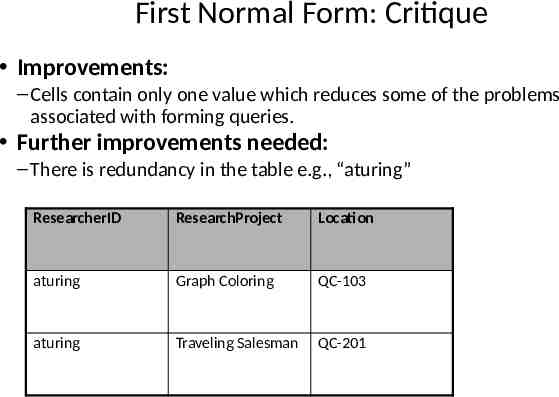
First Normal Form: Critique Improvements: – Cells contain only one value which reduces some of the problems associated with forming queries. Further improvements needed: – There is redundancy in the table e.g., “aturing” ResearcherID ResearchProject Location aturing Graph Coloring QC-103 aturing Traveling Salesman QC-201
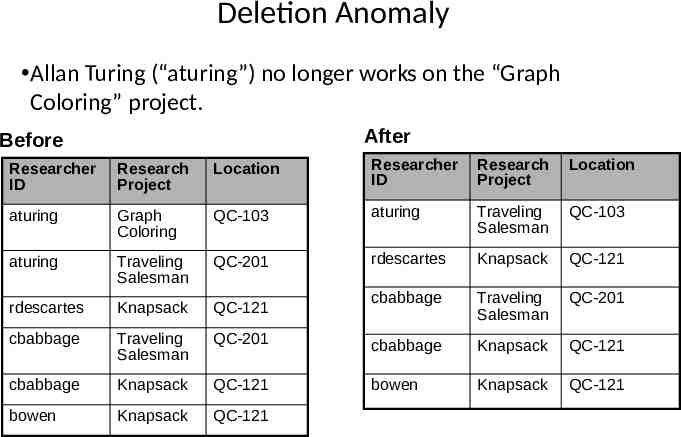
Deletion Anomaly Allan Turing (“aturing”) no longer works on the “Graph Coloring” project. After Before Researcher ID Research Project Location Researcher ID Research Project Location aturing Graph Coloring QC-103 aturing Traveling Salesman QC-103 aturing Traveling Salesman QC-201 rdescartes Knapsack QC-121 rdescartes Knapsack QC-121 cbabbage Traveling Salesman QC-201 cbabbage Traveling Salesman QC-201 cbabbage Knapsack QC-121 cbabbage Knapsack QC-121 bowen Knapsack QC-121 bowen Knapsack QC-121

Insertion Anomalies A new research project ‘UFO’ is added to the department and room ‘Area-57’ is to be used as the research lab but a researcher has not been hired. This is an incomplete record that cannot yet be properly added to the database (PK researcher and project name) ResearcherID Research project Location aturing Graph Coloring QC-103 aturing Traveling Salesman QC-201 rdescartes Knapsack QC-121 cbabbage Traveling Salesman QC-201 cbabbage Knapsack QC-121 bowen Knapsack QC-121
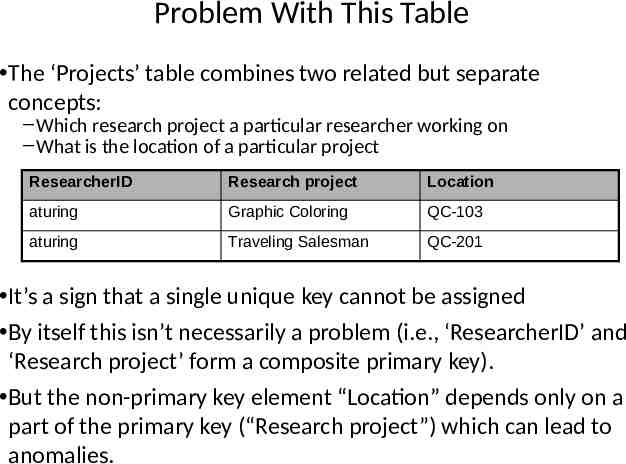
Problem With This Table The ‘Projects’ table combines two related but separate concepts: – Which research project a particular researcher working on – What is the location of a particular project ResearcherID Research project Location aturing Graphic Coloring QC-103 aturing Traveling Salesman QC-201 It’s a sign that a single unique key cannot be assigned By itself this isn’t necessarily a problem (i.e., ‘ResearcherID’ and ‘Research project’ form a composite primary key). But the non-primary key element “Location” depends only on a part of the primary key (“Research project”) which can lead to anomalies.
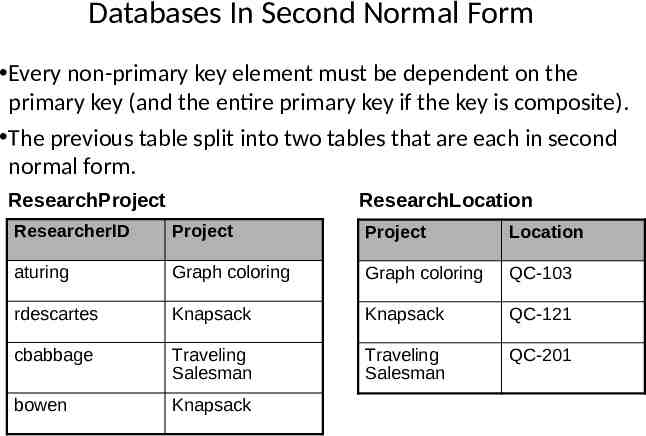
Databases In Second Normal Form Every non-primary key element must be dependent on the primary key (and the entire primary key if the key is composite). The previous table split into two tables that are each in second normal form. ResearchProject ResearchLocation ResearcherID Project Project Location aturing Graph coloring Graph coloring QC-103 rdescartes Knapsack Knapsack QC-121 cbabbage Traveling Salesman Traveling Salesman QC-201 bowen Knapsack

Critique Of Second Normal Form Dependencies can still exist that affects the database but in a slightly more subtle fashion. All non-key fields are dependent upon the primary key but some may be dependent in an indirect fashion.
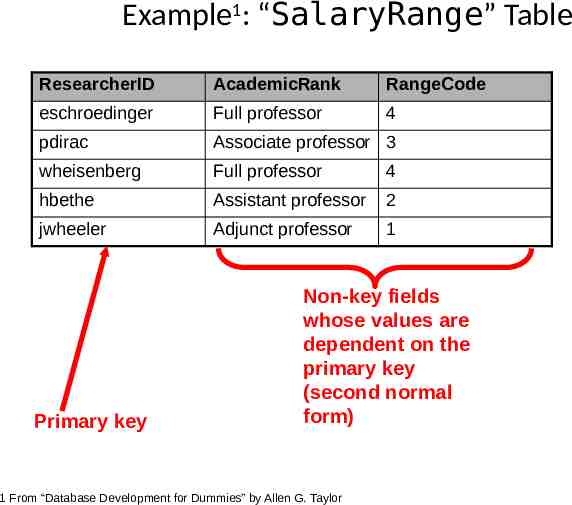
Example1: “SalaryRange” Table ResearcherID AcademicRank RangeCode eschroedinger Full professor 4 pdirac Associate professor 3 wheisenberg Full professor 4 hbethe Assistant professor 2 jwheeler Adjunct professor 1 Primary key Non-key fields whose values are dependent on the primary key (second normal form) 1 From “Database Development for Dummies” by Allen G. Taylor

The Example In 2nd Normal Form Are Still Subject To Some Anomalies Example Professor Dirac leaves the university. Before ResearcherID AcademicRank RangeCode eschroedinger Full professor 4 pdirac Associate professor 3 wheisenberg Full professor 4 hbethe Assistant professor 2 jwheeler Adjunct professor 1 AcademicRank Full professor Full professor Assistant professor Adjunct professor RangeCode 4 4 2 1 After ResearcherID eschroedinger wheisenberg hbethe jwheeler
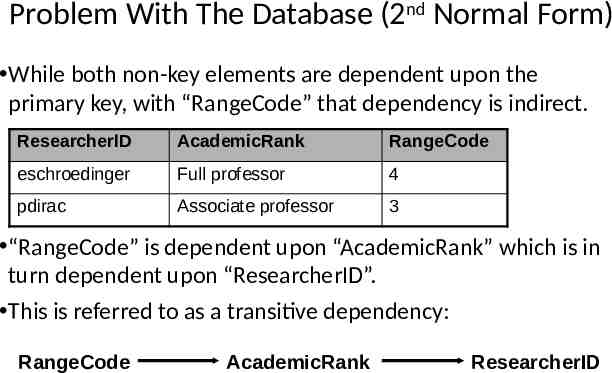
Problem With The Database (2nd Normal Form) While both non-key elements are dependent upon the primary key, with “RangeCode” that dependency is indirect. ResearcherID AcademicRank RangeCode eschroedinger Full professor 4 pdirac Associate professor 3 “RangeCode” is dependent upon “AcademicRank” which is in turn dependent upon “ResearcherID”. This is referred to as a transitive dependency: RangeCode AcademicRank ResearcherID
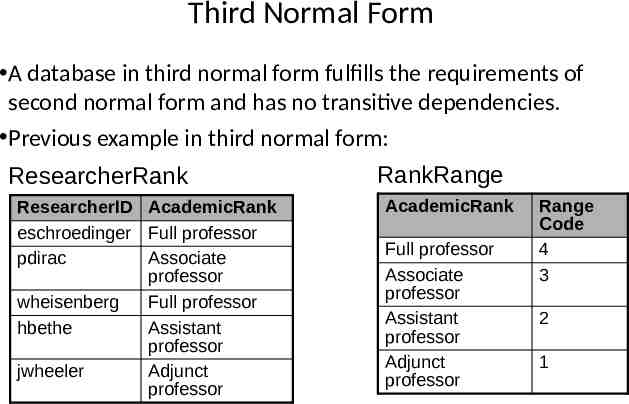
Third Normal Form A database in third normal form fulfills the requirements of second normal form and has no transitive dependencies. Previous example in third normal form: ResearcherRank ResearcherID AcademicRank eschroedinger Full professor pdirac Associate professor wheisenberg Full professor hbethe Assistant professor jwheeler Adjunct professor RankRange AcademicRank Full professor Associate professor Assistant professor Adjunct professor Range Code 4 3 2 1
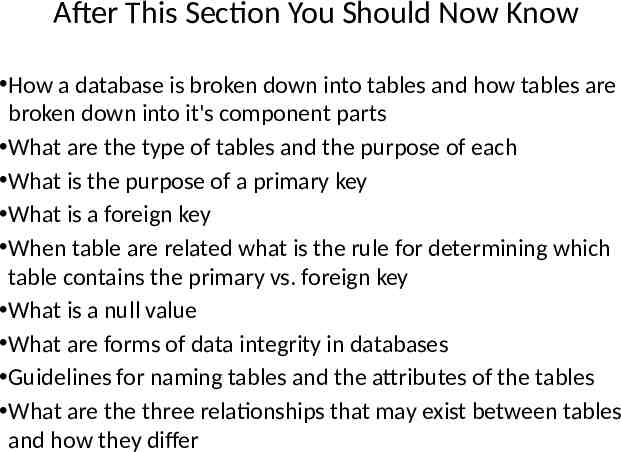
After This Section You Should Now Know How a database is broken down into tables and how tables are broken down into it's component parts What are the type of tables and the purpose of each What is the purpose of a primary key What is a foreign key When table are related what is the rule for determining which table contains the primary vs. foreign key What is a null value What are forms of data integrity in databases Guidelines for naming tables and the attributes of the tables What are the three relationships that may exist between tables and how they differ
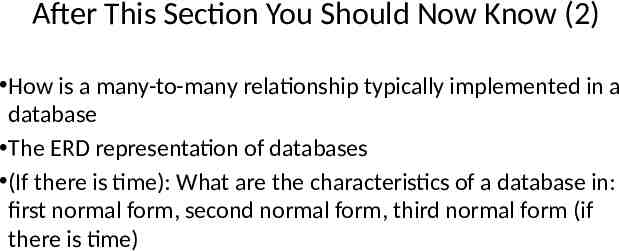
After This Section You Should Now Know (2) How is a many-to-many relationship typically implemented in a database The ERD representation of databases (If there is time): What are the characteristics of a database in: first normal form, second normal form, third normal form (if there is time)






